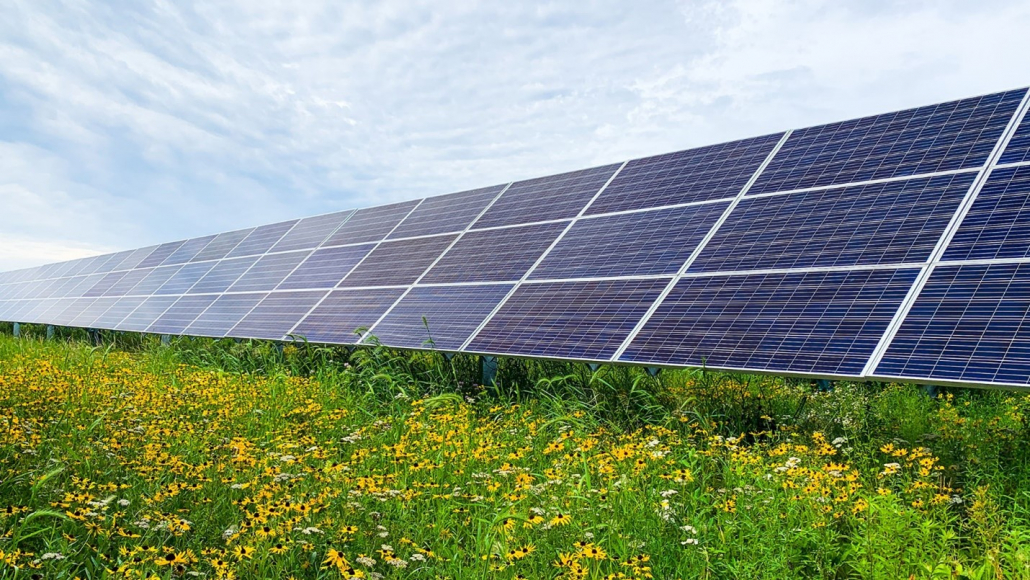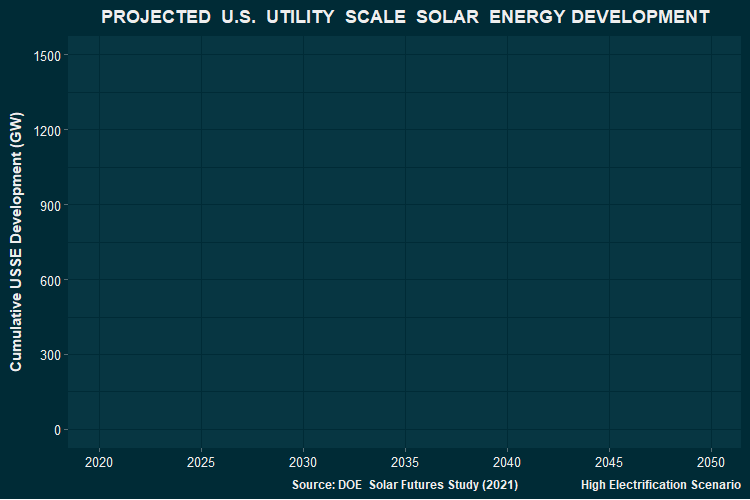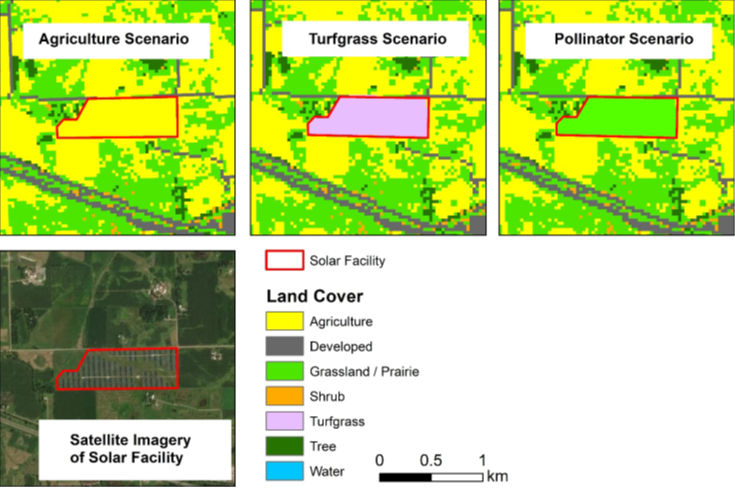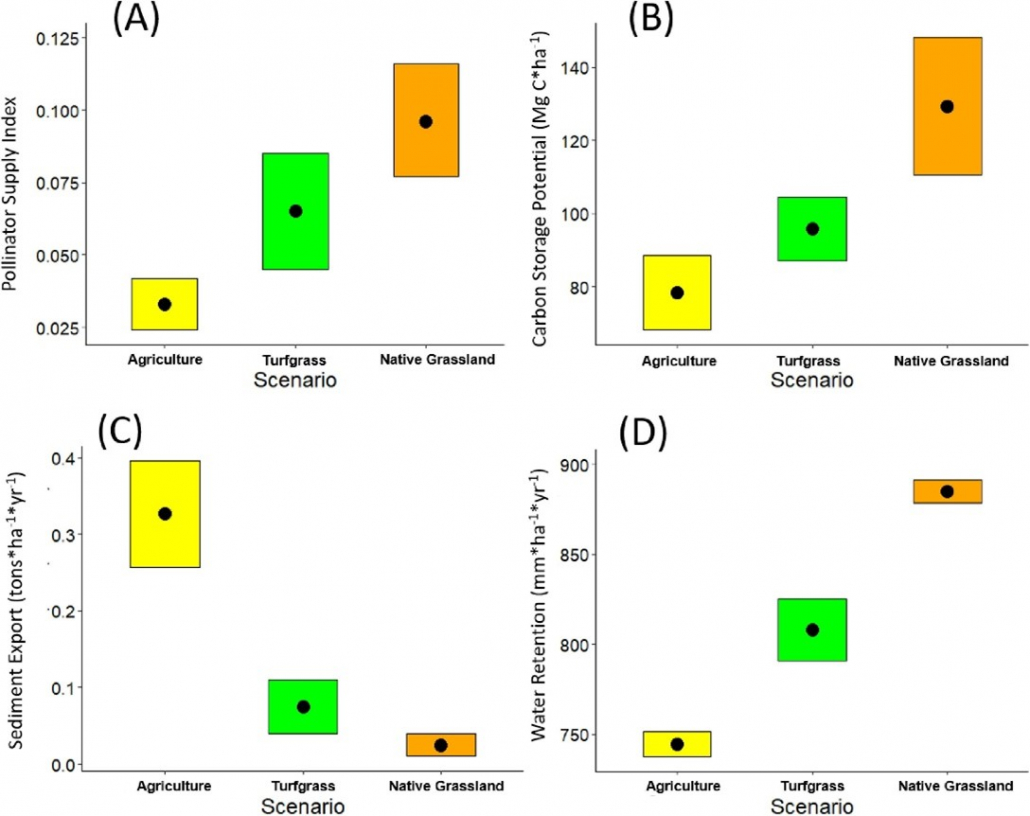By Lee Walston and Heidi Hartmann, Argonne National Laboratory

Many of us have witnessed regional land-use transformations towards renewable energy in the last decade. As the fastest growing electricity generating sector in the U.S., solar energy development has grown more than 20x in the past decade and is projected to be the dominant renewable source of electricity by 2040. The recent DOE Solar Futures Study predicts that over 1 terawatt (TW) of utility-scale solar electricity developments will be required to meet net-zero clean-energy objectives in the U.S. by 2050 (Figure 1). This represents a solar land-use footprint of over 10 million acres across the U.S. – roughly the combined area of Connecticut, Massachusetts, and Rhode Island.

A fundamental question we all face is how to balance solar energy development with other land uses such as agriculture. Given the current and projected land-use requirements, sustained development of solar energy will depend on finding renewable energy solutions that optimize the combined outputs of energy production, ecosystem services, and other land uses. Dual land-use approaches that co-locate solar energy with other forms of land uses, such as agriculture or habitat restoration, have emerged as promising strategies to improving the landscape compatibility of solar energy. The establishment of native pollinator-friendly vegetation at solar facilities (“solar-pollinator habitat”) is one strategy to improve the multifunctionality of these lands that not only provide renewable energy but also offer several ecosystem service benefits such as: (1) biodiversity conservation; (2) stormwater and erosion control; (3) carbon sequestration; and (4) benefits to nearby agricultural fields.
Understanding the true ecosystem service benefits of solar-pollinator habitat will require field studies in different geographic regions to examine the methods of solar-pollinator habitat establishment and link these processes with measured ecosystem service outputs. Given the time required to conduct these direct field studies, most discussions of solar-pollinator habitat thus far have centered on qualitative ecosystem outcomes. Fortunately, there are ways to quantitatively understand some of these potential outcomes. Native habitat restoration has been a focus of scientific research for many years, and we can use these studies to understand the regional methods for solar pollinator habitat establishment (e.g., types of seed mixes, vegetation management) and relate these habitat restoration activities with quantifiable ecosystem responses. For example, there are decades of research on the restoration of the prairie grassland systems in the Midwest and Great Plains – regions that have seen losses of over 90% of their native grasslands due to agricultural expansion.
Because many solar facilities in the Midwest are sited on former agricultural fields, research on ecological restoration of former agricultural fields could be very useful in understanding the establishment and performance of solar-pollinator habitat in the same region. We can look to these studies as surrogate study systems for solar-pollinator habitat and utilize the data from these studies to make inferences on the ecosystem outcomes of solar-pollinator habitat. Along with a team of research partners, we recently took this approach to quantify the potential ecosystem services of solar-pollinator habitat in the Midwest. Our goal was to understand how solar energy developments co-located with pollinator-friendly native vegetation may improve ecosystem services compared to other traditional land uses. We began by reviewing the literature to collect a range of data on vegetation associated with three different land uses: agriculture, solar-turfgrass, and solar-pollinator habitat. The data for each land use included information on vegetation types, root depths, carbon storage potential, and evapotranspiration, to name a few.
We then developed ecosystem service models for each land use scenario. The land uses corresponded to the following scenarios (Figure 2):
1. Agriculture scenario (baseline “pre-solar” land use);
2. Solar-turfgrass (“business as usual” solar-turfgrass land use) and
3. Solar-pollinator habitat (grassland restoration at solar sites).
We mapped and delineated 30 solar sites in the Midwest and used the InVEST modeling tool to model the following four ecosystem services across all sites and land-use scenarios:
- Pollinator Supply (Pollinator Model)
- Carbon Storage Potential (Carbon Storage Model)
- Sediment Export (Sediment Delivery Ratio Model)
- Water Retention (Annual Water Yield Model)

Our results, published in the journal Ecosystem Services, found that, compared to traditional agricultural land uses, solar facilities with sitewide co‑located, pollinator‑friendly vegetation produced a three-fold increase in pollinator habitat quality and a 65% increase in carbon storage potential. The models also showed that solar-pollinator habitat increased the site’s potential to control sedimentation and runoff by more than 95% and 19%, respectively (Figure 3). This study suggests that in regions where native grasslands have been lost to farming and other activities native grassland restoration at solar energy facilities could represent a win‑win for energy and the environment.
What do these results mean? We hope these results can help industry, communities, regulators, and policymakers better understand the potential ecosystem benefits of solar-pollinator habitat. These findings may be used to build cooperative relationships between the solar industry and surrounding communities to better integrate solar energy into agricultural landscapes. While our study provides a quantitative basis for understanding these potential ecosystem benefits, additional work is needed to validate model results and collect the primary data that would support economic evaluations to inform solar-native grassland business decisions for the solar industry and quantify the economic benefits of services provided to nearby farmers, landowners, and other stakeholders.

